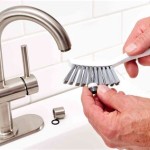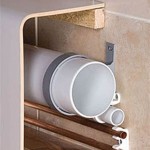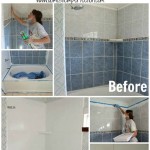Why Does My Bathroom Smell Mouldy?
A mouldy smell in a bathroom is a common domestic issue, often indicative of underlying problems related to moisture, ventilation, and hygiene. Identifying the root cause of the odour is crucial to implementing effective solutions and preventing the growth of mould, which can pose health risks and cause structural damage over time. This article will explore the primary reasons for a mouldy smell in the bathroom, outlining potential culprits and strategies for detection and remediation.
Poor Ventilation and High Humidity
Bathrooms, by their very nature, are prone to high humidity levels. Showers, baths, and even handwashing contribute significantly to moisture accumulation in the air. When this moisture is not adequately dispersed, it creates an environment conducive to mould growth. An inadequate ventilation system is a primary contributor to persistent humidity. This may manifest as a non-functional exhaust fan, a fan that is too small for the bathroom's size, or a lack of any mechanical ventilation altogether. Windows, if present, may not be opened regularly, further hindering natural airflow. The warm, humid air becomes trapped, condensing on surfaces such as walls, ceilings, and tiles, providing the necessary moisture for mould to thrive. This is especially true in poorly insulated bathrooms where temperature differences exacerbate condensation.
Furthermore, the materials commonly used in bathrooms, such as drywall, grout, and wood, are porous and can readily absorb moisture. Once these materials become saturated, they provide a breeding ground for mould spores, which are ubiquitous in the environment. The elevated humidity levels prevent these materials from drying out completely, allowing mould to proliferate. The mould then releases volatile organic compounds (VOCs), including microbial VOCs (MVOCs), which are responsible for the musty, mouldy smell. The presence of these VOCs is a clear indication that mould is actively growing and producing these compounds as a byproduct of its metabolism. Without addressing the underlying ventilation and humidity issues, the mouldy smell will persist, regardless of surface cleaning efforts.
To address this, the functionality and adequacy of the bathroom's ventilation system should be evaluated. If an exhaust fan is present, ensure it is working correctly and is appropriately sized for the room. A simple test involves holding a piece of tissue paper near the fan while it is running; if the fan is functioning properly, it should hold the tissue paper in place. If the fan is inadequate or non-existent, consider installing a more powerful model or a fan incorporating a humidity sensor that automatically activates when moisture levels rise. Regularly opening windows after showering or bathing can also significantly reduce humidity. In addition, using a dehumidifier in the bathroom, especially during periods of high humidity, can help to lower moisture levels and inhibit mould growth.
Hidden Leaks and Water Damage
Another significant cause of a mouldy smell is the presence of hidden leaks and water damage. These leaks can originate from various sources, including faulty plumbing, leaking showerheads, or poorly sealed tiles and grout. Even small, seemingly insignificant leaks can contribute to significant moisture accumulation over time, particularly behind walls, under flooring, or within cabinets. The constant presence of moisture creates a perfect environment for mould to grow, often undetected until the problem becomes severe and the characteristic musty odour becomes noticeable. These hidden leaks can be particularly problematic because they allow mould to grow in inaccessible areas, making remediation more complex and costly.
Common areas susceptible to leaks include the seals around bathtubs and showers, the connections to toilets and sinks, and the plumbing pipes running within the walls. Over time, these seals and connections can deteriorate, leading to slow, persistent leaks. Water can seep behind tiles, into the wall cavities, or beneath the flooring, creating a damp environment that fosters mould growth. The type of material in the surrounding environment also contribute to the mold. For instance, drywall is paper-based and readily absorbs water, serving as an excellent food source for mould. Similarly, wood framing and subflooring can become waterlogged and provide a substrate for mould to colonize. The resulting mould growth can spread rapidly, leading to structural damage and exacerbating the mouldy smell.
Detecting hidden leaks requires careful inspection and, in some cases, professional assistance. Look for signs of water damage, such as discoloured or stained walls, bubbling paint, or warped flooring. Check the grout lines between tiles for cracks or deterioration, as these can allow water to penetrate. Examine the areas around faucets, showerheads, and toilets for any signs of leakage. A moisture meter can be used to detect elevated moisture levels in walls and floors, even in areas that appear dry. If a leak is suspected but cannot be located, it may be necessary to consult a plumber or a professional mould inspector. Addressing leaks promptly is crucial to preventing further water damage and inhibiting mould growth. Once the leak is repaired, the affected areas must be thoroughly dried and, if necessary, treated with a disinfectant to kill any existing mould spores.
Organic Matter and Biofilms
The presence of organic matter in the bathroom can also contribute to a mouldy smell, even in the absence of obvious leaks or excessive humidity. Organic materials, such as soap scum, hair, skin cells, and other bathroom debris, can accumulate in drains, on shower curtains, and in other areas of the bathroom. These materials provide a food source for bacteria and other microorganisms, which can produce unpleasant odours as they decompose the organic matter. Furthermore, these microorganisms can form biofilms, which are slimy layers of microorganisms that adhere to surfaces. These biofilms can trap moisture and organic matter, creating an environment conducive to mould growth and contributing to the mouldy smell.
Shower curtains and liners are particularly susceptible to the accumulation of organic matter and biofilm formation. Water splashes onto the curtain during showers and baths, carrying with it soap scum, body oils, and other debris. These materials can adhere to the curtain's surface, providing a food source for bacteria and fungi. Over time, a slimy biofilm can develop, which not only looks unsightly but also contributes to the mouldy smell. Similarly, drains can become clogged with hair, soap scum, and other organic matter, creating a breeding ground for bacteria and other microorganisms. These microorganisms can break down the organic matter, producing foul-smelling gases, including hydrogen sulphide, which can contribute to the overall mouldy odour in the bathroom.
To combat the build-up of organic matter and biofilms, regular cleaning is essential. Shower curtains and liners should be washed or replaced periodically to remove accumulated soap scum and prevent biofilm formation. Drains should be cleaned regularly to remove hair and other debris. Using a drain cleaner or a mixture of baking soda and vinegar can help to dissolve organic matter and prevent clogs. Surfaces in the bathroom, such as tiles, countertops, and sinks, should be cleaned regularly with a disinfectant to kill bacteria and fungi and prevent biofilm formation. Areas prone to moisture accumulation, such as the corners of the shower and the base of the toilet, should be given particular attention. By maintaining a clean and hygienic bathroom environment, the build-up of organic matter and biofilms can be minimized, helping to reduce the likelihood of a mouldy smell.

Why Does My Bathroom Smell Like Mildew Bioclean Remediation Llc

Why Does My Bathroom Smell Like Mildew Bioclean Remediation Llc

Why Is There A Stagnant Smell In The Bathroom

Why Does My Shower Drain Smell Bad Kay Plumbing Heating And Cooling

Moldy Smelling Water From Bathroom Faucet Hometalk

What To Do When The Bathroom Sink Smells Like Mildew Mold Smell

Musty Smells In The Bathroom Clever Ideas For Odor Removal

5 Ways To Get Rid Of That Mildew Odor In Your Bathroom For Good

Musty Smells In The House Finding Them And Getting Rid Of

Musty Smells In The Bathroom Clever Ideas For Odor Removal
Related Posts







